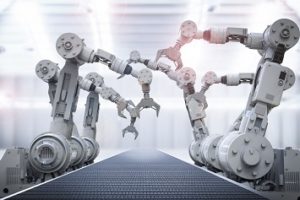On June 18, 2016, bride-to-be Regina Elsea showed up for her shift as a temporary employee at the Ajin plant in Cusseta, Alabama. The plant, which makes metal parts for Hyundai and Kia vehicles, was built in 2008 and is heavily automated. When a sensor fault shut down a robotic production line, Elsea and three coworkers entered the robot’s station to clear a sensor fault. The robot started unexpectedly, catching and crushing Elsea just 2 weeks before her planned wedding.

PhonlamaiPhoto / iStock / Getty Images Plus / Getty Images
It wasn’t an isolated incident. On July 1, 2015, a 22-year-old technician at a Volkswagen plant in Kassel, Germany, was killed while installing a robot; the robot struck him in the chest and crushed him against a metal plate. Just days later, on July 7, 2015, 57-year-old Wanda Holbrook, a freelance maintenance technician died at Ventra Main, an auto-parts manufacturing plant in Ionia, Michigan. Holbrook was killed when a robotic arm unexpectedly swung into the area where she was working and crushed her head against a hitch assembly.
Although science-fictional robots often recognize danger to the humans they serve and act to avert it—like the robot from the television show Lost in Space, who warned young Will Robinson of danger—modern industrial robots are far less developed. They generally don’t have the capacity to recognize a human, let alone that they are endangering one. That puts the burden on humans to recognize and minimize their exposure to harmful situations.
Humans in Harm’s Way
In their favor, it should be noted that robots in the workplace are generally intended not only to make production more efficient but also to make it safer. The work done by robots is often unsafe for humans in some way. Robots who perform painting and spraying operations or welding reduce human exposure to hazardous airborne contaminants; robots who perform materials handling reduce the human risk of back and shoulder injuries. Robots who perform assembly tasks and other highly repetitive work reduce human exposure to ergonomic stressors.
When humans are shielded from these hazards, they are often shielded from contact with the robots, too. Robots perform their work inside enclosures of various types—spray booths, for example, or cages. That means that humans are most likely to interact with robots during nonproduction activities—the Volkswagen worker was installing a robot; Regina Elsea was dealing with a malfunction; Wanda Holbrook was performing periodic maintenance. Setup, testing, adjustment, and maintenance of robots often place the worker within the robot’s area of operation, putting the worker at risk of injury.
According to the Occupational Safety and Health Administration (OSHA), accidents involving robots and humans can be grouped into four categories:
Impact or Collision Accidents. These types of contact accidents occur as a result of unpredicted movements, component malfunctions, or unpredicted program changes related to the robot’s arm or peripheral equipment.
Crushing and Trapping Accidents. This type of accident occurs when a worker’s limb or other body part becomes trapped between a robot’s arm and other peripheral equipment, or when a worker is physically driven into and crushed by other peripheral equipment.
Mechanical Part Accidents. When a robot experiences a breakdown of its drive components, tooling or end-effector, peripheral equipment, or power source, a mechanical accident can result. These may take the form of a release of parts, the failure of a gripper mechanism, or the failure of end-effector power tools (e.g., grinding wheels, buffing wheels, deburring tools, power screwdrivers, and nut runners), among others.
Other Accidents. Robots can also pose hazards as a result of electrical and pressurized fluids used in their operation, such as the hazards posed by ruptured hydraulic lines or arc flash. Metal spatter, dust, electromagnetic, or radio-frequency interference can also occur, and equipment and power cables on the floor can pose tripping hazards.
Tomorrow we’ll look at some ways to prevent hazardous human-robot interactions.
